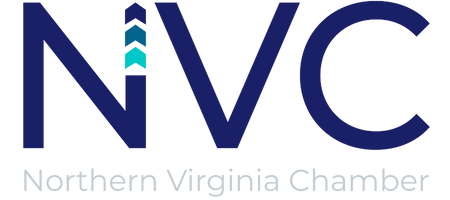“Amid Economic Disruption and Uncertain Labor News, Executives Should Lean Into Communications” is provided by NVC Member D.J. Jordan, Senior Vice President, Pinkston.
The latest jobs report from the Bureau of Labor Statistics raised concerns about the economy and the labor market. Only 22,000 jobs were added in August, and the unemployment rate rose to 4.3%, the highest level since 2021. For the first time since 2020, the economy actually lost more jobs than it gained in June.
Amid nationwide economic disruption driven by emerging AI technologies, there is perhaps no market experiencing more turbulence than the Greater Washington D.C. Region, which is also contending with federal layoffs and tariff uncertainty. The question for business leaders becomes how to instill confidence among their employees, investors, and customers when economic news turns negative, and most Americans are worried about AI causing permanent job loss.
The latest Northern Virginia Chamber (NVC) and Pinkston Business Leader Survey found that executives are not optimistic about the national or regional economic outlook. More than one-third of executives expected the local economy to decline over the next six months, while an additional 26% believed it would remain the same. However, 68% of business leaders remain confident in their own company’s trajectory. Bridging that confidence gap for their stakeholders and employees will require business leaders to take essential steps that will mitigate brewing anxieties and keep their teams engaged, motivated, and productive. Here are three communications strategies to help achieve this:
1. Continue or increase internal communication.
Internal communication is often the missing link between the confidence that executives feel and the anxiety many employees carry. In uncertain times, especially, silence or vague messaging widens the gap. Clear, frequent communication helps employees understand the context for decisions, easing the insecurity that headlines about layoffs and economic slowdowns may bring up.
Remember: an anxious employee is probably an unproductive employee.
Effective communication can take many forms, including internal newsletters, leadership updates, and direct face-to-face engagement that help defuse tension and restore confidence. Leadership presence, even in informal settings, creates an opportunity to project self-assuredness, reinforce stability, and strengthen trust.
Additionally, forums like team meetings and town halls with senior leaders build openness and alignment to keep employees informed and engaged. While managers often drive employee engagement at work, a common reason that employee engagement efforts fail is due to a lack of executive ownership and prioritization. A 2024 Gallup study showed that better employee engagement at work resulted in a 14% increase in employee productivity, a 23% boost in profitability, and an 81% reduction in absenteeism.
I saw the impact of leadership presence firsthand during my tenure at the Virginia Office of the Attorney General in Richmond. The Attorney General, Jason Miyares, and senior staff made a point to periodically walk the halls of our 11-story headquarters, meeting colleagues face-to-face.
Each month, we visited a different floor or department, listening, answering questions, and putting names to faces. Working in state politics, change and uncertainty come with the territory, and this small gesture created a sense of community. Employees would frequently provide feedback about being pleasantly surprised to see the Attorney General walking the halls. This visible presence didn’t erase uncertainty completely, but it helped staff feel connected to leadership and prepared to face change. This is the kind of reassurance that many American employees need now.
2. Honesty and authenticity are non-negotiable policies.
Leaders must also provide employees with candid information about company performance. This transparency must extend to difficult decisions such as layoffs, and the external factors influencing these outcomes and the decisions that follow.
Authenticity is especially a make-or-break quality in a leader for Gen Z employees. In an EY survey, more than 90% rated “being authentic” as “extremely” or “very important.” With this in mind, every message should be treated as if it could be made public and be consistent with the organization’s external voice.
At the same time, as a substantial portion of recent college graduates, Gen Z has been among the most affected by AI’s growing presence in business operations. And when uncertainty rises, it can reduce productivity, creativity, and morale.
Last year, global employee engagement dropped to 21%, costing the economy an estimated $438 billion, according to the Gallup State of the Global Workplace. Unengaged employees are 18% less productive than their engaged peers, and once employees identify their workplace culture as “toxic”, nearly 60% of them will start looking for a new job. Disengagement is difficult in any season, but in this moment of labor disruption, it could be the difference between recovery and decline.
Engagement drives performance and productivity. However, to maintain this engagement, leaders must communicate clearly and compassionately to instill trust within their teams. Failure to do so could lead to messages that come off as tone-deaf or disingenuous, which can add to tension during challenging times.
In short, emotionally intelligent communication is essential. Leaders and managers must check in with employees, acknowledge challenges, and frame uncertainty as an opportunity for innovation and growth.
3. Cast a vision for the future and inspire employees to take part in it.
A final important leadership encouragement is to turn alignment into action. They must present the organization’s path forward in a way that truly motivates employees to bring their best selves to their work.
People need hope. Good leaders provide realism and optimism inside and outside the organization, painting a picture of future innovation and better service to people. Internal and external communications must be aligned to maintain credibility with both internal and external stakeholders, including key stakeholder groups such as customers and investors. Close alignment will strengthen an organization’s messaging, identity, and brand while protecting its overall reputation.
Visionaries and entrepreneurial leaders often have creative and bold ideas in mind, but they sometimes struggle to explain them in a way that galvanizes their team. If you want a productive staff who will operationally carry out your vision, you must spend time inspiring them first.
Business leaders in the Greater Washington area — and throughout the U.S. — have much to be optimistic about; now it’s up to us to instill that optimism in our staff through our communications and culture. That doesn’t happen solely through annual meetings or corporate retreats: strong company cultures are shaped by consistent engagement and inspiring messages. Especially in uncertain times, leaders must be strategic about how to build a culture where employees and customers feel supported and motivated. By pairing a confident internal presence with a unified external message, leaders can do more than steady their organizations – they can make their people believe in the future alongside them.
 As a Senior Vice President at Pinkston, D.J. leads a team of strategists, writers, and designers in creating and implementing strategic communications campaigns and crisis response plans for corporations, nonprofit organizations, government agencies, and advocacy groups.
As a Senior Vice President at Pinkston, D.J. leads a team of strategists, writers, and designers in creating and implementing strategic communications campaigns and crisis response plans for corporations, nonprofit organizations, government agencies, and advocacy groups.










